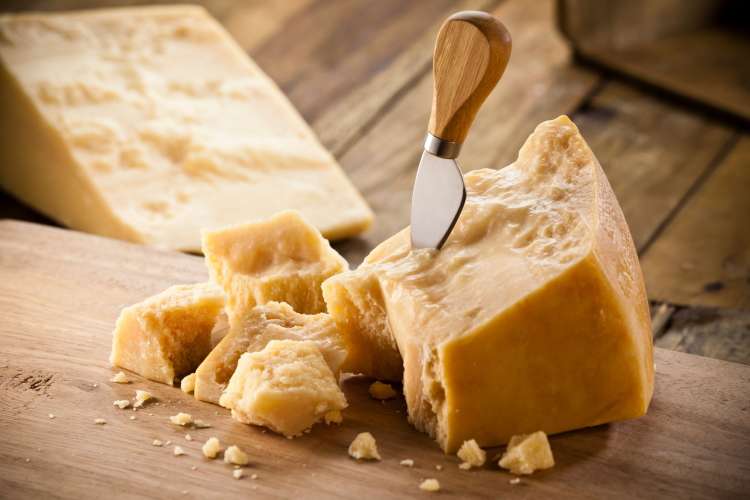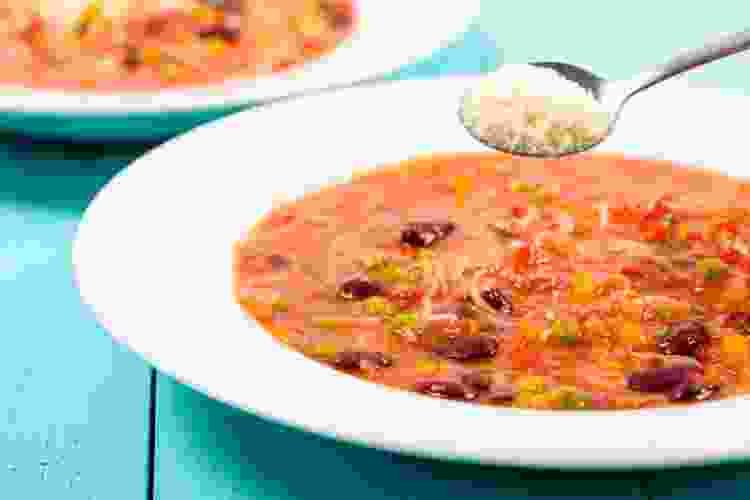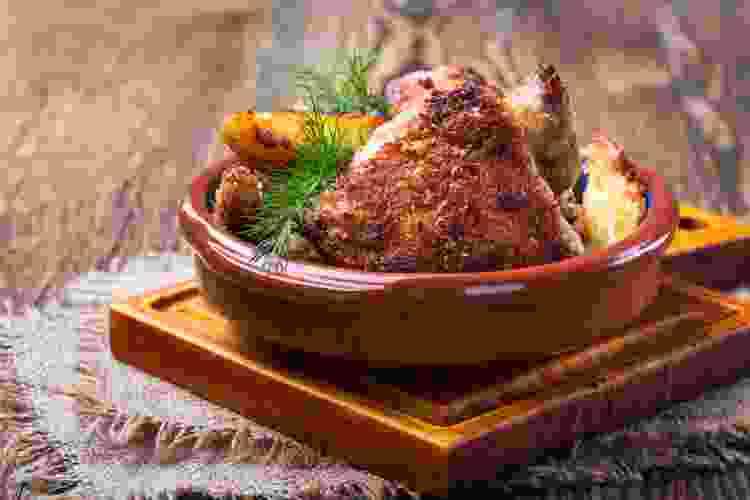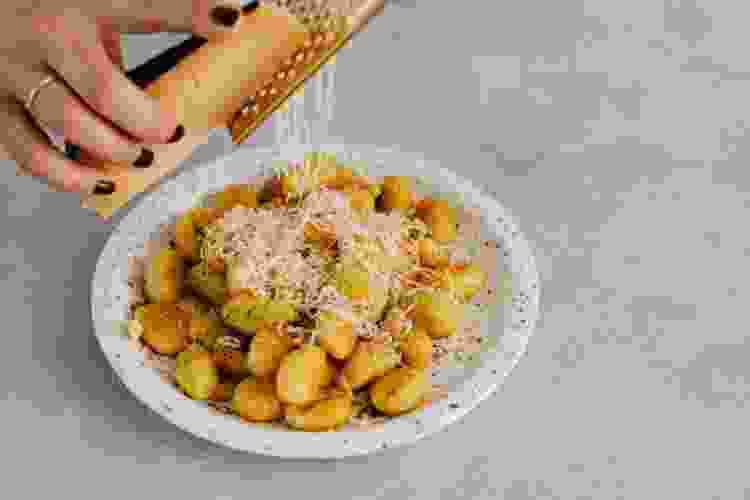Parmesan Cheese: The King of Italian Cheeses in 2025

It’s tough to sum up the taste of Parmesan cheese with words alone. It hits hard with sharp, salty notes, then lingers with a nutty, almost fruity finish. More than just a pasta topper, this aged Italian cheese brings depth to everything it touches — and has the history and nutrition profile to match.
To really get the most out of it in your kitchen, you need to know what you’re working with. Here’s what makes Parmesan cheese stand out, and why it continues to reign supreme.
Jump to Section
- What is Parmesan Cheese?
- The History and Production of Parmesan Cheese
- Parmesan Cheese Pronunciation and Etymology
- Flavor Profile of Parmesan Cheese
- Types of Parmesan Cheese
- Uses for Parmesan Cheese
- Parmesan Cheese Recipes
- Parmesan Cheese and Pairings
- Health Benefits of Parmesan Cheese
- Parmesan Cheese Price and Where to Buy It
- Parmesan Cheese FAQs
What is Parmesan Cheese?

Parmesan cheese is a hard, aged cheese known for its grainy texture, rich umami, and sharp, nutty flavor. But not all Parmesan is created equal. The real deal is Parmigiano Reggiano — an Italian cheese with centuries of tradition and strict production standards.
Outside Europe, the term “Parmesan” often gets used more loosely. In places like the United States, it can refer to cheeses made in a similar style but without the same rules, aging, or depth of flavor. These versions are usually milder, sometimes made with additives, and still work fine grated over pasta or salads — just don’t mistake them for the original.
All Parmigiano Reggiano is Parmesan, but not all Parmesan is Parmigiano Reggiano.
The History and Production of Parmesan Cheese
Parmesan cheese, known in its purest form as Parmigiano Reggiano, has nearly 900 years of history rooted in northern Italy. It was first created by Benedictine and Cistercian monks in the Middle Ages, who had access to salt from Salsomaggiore, lush pastures and high-quality milk. Their goal? A cheese that could last, was firm, flavorful and built for long storage without spoiling.
What they created wasn’t just durable — it was delicious. And perfect for trade.
Early History

The earliest known mention of Parmigiano Reggiano dates back to 1254, when it was described in a notarial deed as caseus parmensis (cheese of Parma). By the 14th century, its fame had spread across Italy. Boccaccio even wrote of “grated Parmigiano over macaroni and ravioli” in The Decameron. Its growing reputation soon reached markets beyond Italy, including France, Germany and Flanders.
In 1612, the Duke of Parma issued one of the earliest official designations of origin to protect its authenticity. Over time, more safeguards followed, eventually leading to the creation of the Consorzio del Parmigiano Reggiano in the 20th century, the official body that upholds strict production rules and quality standards.
Modern Protections
Today, Parmigiano Reggiano holds PDO (Protected Designation of Origin) status under European Union law. This designation ensures that only cheeses produced in specific provinces, Parma, Reggio Emilia, Modena and parts of Bologna and Mantua, using approved methods and ingredients, can carry the Parmigiano Reggiano name. Every step, from sourcing fodder to aging the cheese, must take place within these regions.
Traditional production remains largely unchanged. Raw cow’s milk, rennet and salt are used without additives or preservatives. The curds are heated, formed into wheels and aged for at least 12 months, and often much longer, in temperature-controlled aging rooms. As the cheese matures, it develops its hallmark crumbly texture and signature nutty, deeply savory flavor.
Parmesan Cheese Pronunciation and Etymology
In Italian, Parmigiano Reggiano is pronounced par-mee-JAH-no reh-JEE-ah-no. The term “Parmesan” comes from the French take on the word Parmigiano and refers to its place of origin — Parma, in northern Italy. Over time, “Parmesan” became the everyday English word for this type of cheese, though not every Parmesan out there meets the same standards as the original.
Flavor Profile of Parmesan Cheese
Parmesan has a bold, savory flavor with nutty richness, a hint of sweetness and a salty edge. Its intensity deepens with age, and no matter how it’s served — shaved, grated or broken off in chunks — the cheese delivers a sharp, complex bite that lingers on the palate.
Types of Parmesan Cheese

Parmesan cheese comes in a few familiar forms: grated, block, powdered and whole wheel. Grated Parmesan is pre-shredded and easy to toss onto pasta or salad, though it often includes anti-caking agents and the flavor can fall a bit flat compared to the real thing. Block Parmesan, sold in wedges, keeps things a bit fresher — you’ll need a grater or knife, but the payoff is a richer taste and better texture.
Powdered Parmesan is shelf-stable and finely ground, usually found in bulk or packaged goods. It does the job in a pinch, but often contains additives and lacks depth. A whole wheel of Parmesan is the real deal. It's aged, full-flavored and traditional. It’s not something most home cooks buy, but in restaurants or for special occasions, it brings serious quality.
Uses for Parmesan Cheese
Parmesan cheese earns its place in just about every part of the kitchen. It adds a salty, nutty punch to hot dishes, cold salads and even snack boards when you need something with bite. You can shave it, grate it, melt it or let it stand on its own. This isn’t just a garnish.
Pasta, Pizza and Risotto

It’s the finishing move for most pasta dishes, but Parmesan also melts beautifully into risotto, where it adds both flavor and creaminess. Freshly grated over a simple tomato pizza, it brings sharpness that cuts through the sauce. Skip the pre-grated stuff if you want the real payoff — nothing beats shaving it straight from the block.
Salads, Soups and Roasted Vegetables

Toss shavings into a Caesar salad or any mix of bitter greens. Stir it into soup just before serving to thicken the broth and round out the flavor. Roasted vegetables also love Parmesan — a handful tossed on top at the end gives them a savory, golden finish without much effort.
Cheese Boards and Snacks

Parmesan’s crumbly texture and deep flavor make it a smart pick for cheese board ideas. And if you’re putting together Christmas charcuterie board ideas, a few shards of aged Parmesan can go a long way. Break it into bite-sized chunks and pair it with balsamic vinegar, olives or dried fruit. It holds up on its own and balances out richer, softer cheeses.
Parmesan Cheese Recipes
When you’ve got a wedge of the good stuff, you don’t need complicated recipes. Just a few ingredients and a bit of heat go a long way. These two meals let Parmesan shine.
Easy Parmesan-Crusted Chicken

This is dinner without much fuss. Dip chicken breasts in beaten egg, coat them with a mix of breadcrumbs and grated Parmesan, then bake until golden and crisp. The cheese gives it a nutty crust and keeps the inside juicy. Serve it with greens, potatoes or anything that balances the crunch.
Simple Parmesan Herb Pasta

Cook spaghetti or linguine until just tender, then toss it in garlic-infused olive oil with a splash of pasta water. Stir in Parmesan and a handful of fresh herbs. It melts into a glossy sauce that’s simple and satisfying, perfect for when you want something comforting that doesn’t take all night.
Parmesan Cheese and Pairings

Parmesan cheese pairs well with a few different styles of wine, depending on how you’re serving it. Lambrusco is a go-to option — it comes from the same part of Italy and has just enough fizz and fruit to balance out the saltiness. If you’re after something bolder, a glass of Chianti or Barolo works well too.
For lighter pairings, a dry white like Sauvignon Blanc or a crisp Riesling adds a nice contrast. And if you want something a bit more festive, Prosecco or Champagne brings a bit of brightness that cuts through the richness without clashing.
Health Benefits of Parmesan Cheese

Parmesan isn’t just a flavor bomb, it also packs a surprisingly nutritious punch. Thanks to its long aging process and simple ingredients, it’s one of those rare foods that hits both the taste and health checkboxes.
Parmesan is rich in complete, high-quality protein containing all essential amino acids. During its long aging process, the proteins are broken down into smaller, more digestible pieces, making them easier to absorb.
Then there’s the bone-friendly nutrient trio: calcium, phosphorus and zinc. These three minerals are vital for strong bones and teeth. And Parmesan delivers all three in spades, and because of how it’s made, your body has an easier time absorbing them. Just one ounce provides 26% of the recommended daily value for calcium.
And although it’s made from milk, Parmesan is virtually lactose-free. The aging process eliminates almost all the lactose, making it a smart option for people with sensitivities.
It also packs a punch in a small serving. One ounce gives you around 111 calories, 10 grams of protein and 26% of your daily calcium needs — all without a big carb load.
Finally, there’s the fat. Parmesan contains short- and medium-chain fatty acids, which are easier to metabolize and less likely to be stored as body fat. Pair that with its natural ability to fill you up, making it easier to manage your appetite and avoid overeating.
Parmesan Cheese Price and Where to Buy It
You can find real Parmigiano Reggiano at most specialty cheese shops or Italian grocers — and yes, it’s worth the extra trip. That said, larger retailers like Sam's Club often carry the real deal too. Just look closely at the label.
Prices vary depending on age and origin, but expect to pay somewhere between $10 and $20 per pound. The longer it’s aged, the more intense (and pricey) it gets.
Parmesan Cheese FAQs
What Are the Parmesan Cheese Substitutes?

If you’re out of Parmesan and need something similar in texture or flavor, try cotija, aged asiago cheese, or dry jack. These cheeses won’t taste exactly the same, but they can work in a pinch for grating over pasta or adding a salty, savory kick. Vegan options like nutritional yeast or plant-based parmesan can also work for specific dietary needs, though the flavor is very different.
Is Parmesan Cheese Healthy To Eat?
In moderation, yes. It’s rich in calcium and protein and fairly low in carbs. Just keep an eye on the salt and fat content — you don’t need a lot to get the flavor payoff.
What Are the Two Types of Parmesan Cheese?
Strictly speaking, Parmigiano Reggiano is the only cheese that should be called “Parmesan” under European law. But in practice, people often group Grana Padano and Pecorino Romano cheese into the same category because they’re hard, aged Italian cheeses used in similar ways. They're not types of Parmesan, but they show up in the same recipes and get compared often.
Can You Eat Parmesan by Itself?
Yes, you definitely can. Parmesan is one of the more delicious types of cheese and offers nothing to be desired when eaten alone.
Do You Have to Refrigerate Parmesan Cheese After Opening?
While refrigeration isn’t strictly required for safety, it’s highly recommended. While it’s a hard cheese that holds up at room temperature for short periods, refrigeration helps it last longer. An opened wedge should keep in the fridge for 3 to 4 weeks; shredded Parmesan is best used within a month.
Parmesan cheese isn’t just a topping — it’s a pillar of Italian cooking and a staple in kitchens around the world. From a massive aged wheel to a simple dusting over dinner, Parmesan brings bold flavor, deep tradition and a whole lot of character. It deserves more than just a spot on your pasta. However you use it, just make sure it’s the real thing.
For even more fun foodie ideas, check out other experiences happening on Classpop!

